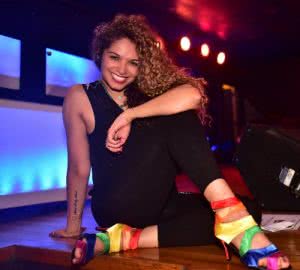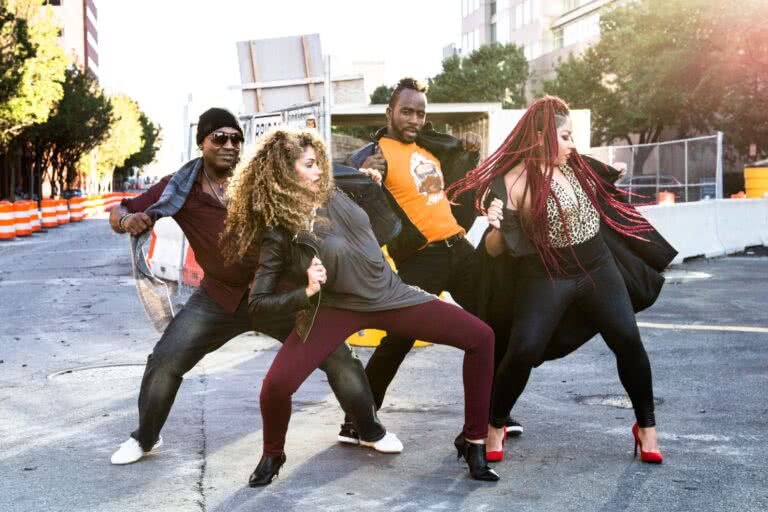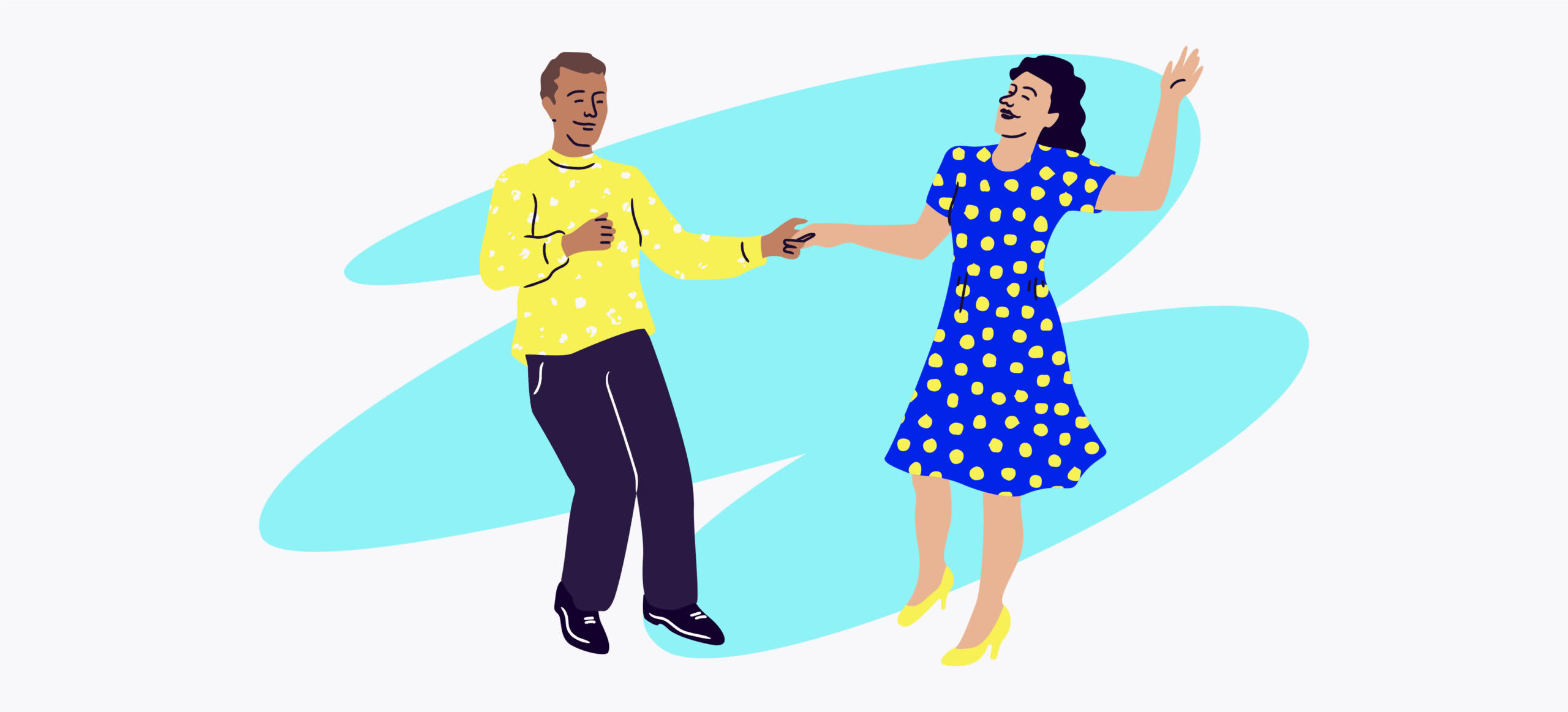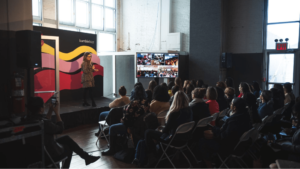Ana Masacote is used to adapting on the fly. While studying electrical engineering and computer science at MIT, Mascote decided to pursue a career in dance, switching to MIT’s management science program in 2001. Two years later, she co-founded the dance company Masacote Entertainment and has since travelled the world spreading the gospel of Afro-Latin dance: teaching classes, performing, speaking during panels, and even reading poetry.
“Lately, I’ve been focused on integrating more modes of art within dance, and creating more immersive experiences through art, which is a little harder to do at this moment,” Masacote says. “What’s gonna be interesting is asking ourselves, ‘Is there a way to still create an immersive experience to the virtual world?’ I’m very curious to explore that.”
The Massachusetts-based queer dancer already had an online dance academy with pre-recorded videos set up prior to the COVID-19 pandemic, but it’s geared toward advanced students. With more and more people craving live experiences online, the 37-year-old has had to rethink how to approach dance in the virtual space. When Eventbrite reached out to see if she wanted to host a live event during the 12-hour online Pride festival We’re Still Here on June 12, Masacote got thinking.
“My first thought was ‘Hell yes,’ ” Masacote says. “The second thought was: ‘What can I create that will not feel like just a regular class that anybody can create?’ Something that could reach people from all walks of life and from different dance styles. What is it that people need at this moment? And how can I design something that can feel like it’s healing while still providing a sense of community and making people want to get up and dance?”
She settled on a loose and intimate 30-minute nonstop Afro-Latin dance party called Muévete con Pride! — A Queer Latin Dance Jam Session, her first livestreamed dance event on Instagram Live.
Mascote had just over two weeks to put together her donation-based program — and had to weather some technical difficulties day-of — but still managed to put on a fierce, fun, and surprisingly immersive afternoon dance jam that raised nearly $400.
Here, in her own words, is how she made it happen:
Pick your dance partners
The first thing I did was look for a DJ that could really bring a fun, energetic, feel to the day. I put together a Spotify playlist first, to get a feel of the type of songs and music that I wanted. DJ Snatcher took that, played around with it, and added some of their own music.
It was just supposed to be the DJ and me doing the dancing. A few days before, I started thinking that I wanted more vibe and energy to build off. I confirmed Sasi Marcelino the day before. She’s a very spirited, engaging dancer, and she brings a different energy that I thought was very much needed. With everything happening that week — between Black Lives Matter and the pandemic — I really wanted to focus on bringing Black artists and Afro-Latina artists into the space. I also wanted it to feel that it was inclusive of the community, [that it was] there for everybody.
Get technical and do a test run
I knew that I needed to make sure that the tech sides were on the mark. The first thing was getting it up on Eventbrite, getting the imagery and everything together, figuring out the vibe that we were going for.
Things that you don’t think about until the day of: We tested out the Instagram Live that week a couple times in different scenarios. It was good, but we realized we needed different auxiliary cords for the DJ’s sound mixer. The day of the event, the cables decided that they didn’t want to work. We also ended up switching the phone because a different phone had a better camera. I was going to have an image up front so that people could know what they were logging into. When we made that decision to switch the phone, I forgot to switch that stuff over.
We had to buy some equipment for the DJ, like some of the auxiliary chords that chose not to work. We already had a lot of the smaller things that we were using, like the flag decorations. I had a ring light that I use for my own classes online. We bought some lights that give the color in the room a slightly different effect. The rest of it was pretty low-tech. We had to block out the curtains so that we could keep it darker inside so it still kept more of that club vibe. The biggest cost was the talent.
Don’t be afraid to improvise
Using Instagram’s new Pride filter [a rectangular rainbow frame that was superimposed over the live video] was actually a last-minute thought. I hadn’t seen that launch until a couple days before. That morning, when we were testing it, I thought I’d just use it for a little while, but as we were doing the show, I felt that it connected and it didn’t make sense to change it.
We wanted to keep it indoors, in a smaller dance space in my house, because we wanted people to feel that if they were at home, that we were modeling the same thing that they were going to be experiencing. We were doing an animation, which you get a lot in Afro-Latin dance. It’s just more of an improvisation of what you feel like. It has the feeling of a rumba dance that you get a lot in clubs. We wanted it to feel easy for beginners but also fun for people who’ve been dancing a while.

Ana Masacote
Learn from the experience
I had a lens on the phone so I could not tell how many people were watching. I realized it was really hard to actually respond to people because if I’m dancing, I can’t see my messages. Note to self: I wish I had had somebody else in the background who was able to let me know that there was a request.
I want to debrief with people who attended. I wish I could see all the Instagram Live comments. I know people tuned in from Puerto Rico and Brazil and Scotland, so I think that’s pretty cool. I emailed the attendees that bought the tickets on Eventbrite with a personal thank you.
I brought on one [online viewer] to chat with us live. When we watched the playback on Instagram TV after, we noticed that once we ended that part, the audio didn’t quite fully come back after and I don’t know if that was a glitch. It was nice because you get that interaction, but it’s hard because you don’t really want to lose the sound either.
We all ended on such a high, but if we do it again, I want to figure out how to make it so that those tech glitches don’t happen and ask ourselves what sort of equipment do we really need to make something like this happen? I need to be able to hear the music, plus I need to be able to see and hear people if they talk to me.
Use Eventbrite to get the word out
When I did the Eventbrite page, it helped get the information out. I would definitely do it again and really do a hard push to an email list. I think that Eventbrite was a great way to get the word out for people who don’t follow you on Instagram. I also want to say a big thank you to Eventbrite for thinking about doing something like this and bringing people from different walks of life together into a day of Pride when I know it was really needed.
I had a good time. I hope people did, too, and they felt like they were able to move their bodies, that it was a chance to just decompress. It was a hard day in so many ways in the news cycle, it’s been a hard few weeks, and it’s been a hard few months. I just hope that people were able to get out of their heads and just sink back into their bodies for a moment.






